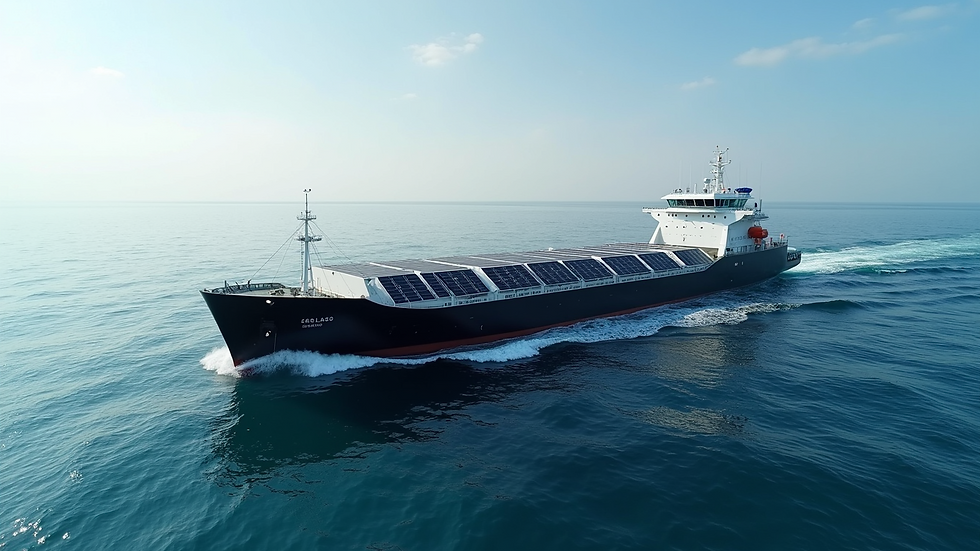Revolutionizing Logistics: The Green Transformation of Freight Forwarding Practices
- ABY FNC Network
- Aug 14
- 3 min read

In recent years, the logistics industry has faced mounting pressure to adopt sustainable practices. With growing global awareness of climate change and its harmful effects on the environment, freight forwarding companies are rising to the occasion. This blog post explores how the freight forwarding sector is going green, highlighting innovative practices and technologies transforming logistics.
The Importance of Sustainable Shipping
Sustainable shipping is vital, not just a trend. The shipping industry contributes significantly to global greenhouse gas emissions. According to the International Maritime Organization (IMO), shipping accounts for about 2.5% of worldwide CO2 emissions. As consumers become more conscious of their environmental footprint, they are seeking greener options, prompting companies to rethink their logistics strategies and adopt more sustainable practices.
Transitioning to sustainable shipping is crucial for lowering the carbon footprint of freight forwarding. Implementing eco-friendly solutions allows companies to comply with regulations while improving their brand reputation and attracting environmentally conscious customers. Notably, studies show that 81% of consumers prefer to buy from companies committed to sustainability.
Innovations in Green Freight Forwarding
Alternative Fuels
One of the most notable advancements in sustainable shipping is the shift towards alternative fuels. Traditional fossil fuels are being increasingly replaced with cleaner options such as biofuels, liquefied natural gas (LNG), and hydrogen. These alternatives produce fewer emissions, substantially minimizing the environmental impact of shipping operations.
For example, some shipping companies are now using biofuels made from waste materials. These sustainable fuels can cut greenhouse gas emissions by up to 80% compared to conventional fuel options. With continued advancements in technology, the adoption of alternative fuels is set to grow, further enhancing sustainable shipping practices.
Energy-Efficient Vessels
The design and construction of vessels are evolving to emphasize energy efficiency. Modern ships now feature advanced hull designs that reduce drag, allowing them to travel more efficiently through water. Additionally, many new vessels incorporate energy-saving technologies, including wind-assisted propulsion systems and solar panels.
These innovations lower fuel consumption and significantly decrease operational costs for freight forwarders. Reports suggest that energy-efficient vessels can reduce fuel costs by up to 30%, showcasing the financial benefits of investing in these sustainable solutions.

Smart Logistics and Route Optimization
Technological advancements in logistics have paved the way for smarter shipping methods. Freight forwarders now use data analytics and artificial intelligence to optimize shipping routes. By considering factors such as weather conditions, traffic patterns, and fuel consumption, companies can identify the most efficient routes.
This approach not only lowers fuel consumption but also shortens delivery times, improving customer satisfaction. For instance, organizations with smart logistics systems have reported a 20% decrease in transit times while also maintaining a lower carbon footprint.
Collaboration and Partnerships
Sustainable shipping is a collective effort that requires cooperation among various stakeholders. Freight forwarders are increasingly partnering with shipping lines, port authorities, and technology providers to develop and implement green initiatives. Such collaborations can lead to shared resources, knowledge exchange, and innovative solutions that benefit the entire supply chain.
A practical example of these collaborations includes efforts to establish green corridors—designated shipping routes for low-emission vessels and sustainable practices. By implementing these corridors, stakeholders can streamline operations and promote environmentally friendly shipping methods.
Regulatory Compliance and Incentives
Governments worldwide are enacting stricter regulations to limit emissions from the shipping industry. To remain compliant, freight forwarders must stay updated on these regulations and adjust their practices accordingly. Compliance helps avoid penalties and positions companies as leaders in sustainability.
Additionally, many governments provide incentives for companies adopting green practices. These incentives may include tax breaks, grants, and subsidies for investing in eco-friendly technologies. Utilizing these incentives allows freight forwarders to offset the costs of transitioning to sustainable shipping methods.
The Role of Consumer Awareness
As consumers become increasingly aware of environmental challenges, their purchasing decisions are influenced by a company's sustainability practices. Freight forwarders that prioritize green initiatives can stand out in a competitive market. By promoting their commitment to sustainability, these companies can attract environmentally conscious customers and foster brand loyalty.
Transparency is essential in this process. Companies should clearly communicate their sustainability efforts and provide information on their practices and environmental impact. This transparency builds trust and encourages other businesses to adopt similar initiatives.
The Path Forward in Sustainable Shipping
The freight forwarding industry is undergoing significant transformation as it embraces sustainable shipping practices. From alternative fuels and energy-efficient vessels to smart logistics and collaborative efforts, the sector is making progress in reducing its environmental impact.
As the demand for greener shipping solutions continues to rise, freight forwarders must be proactive in adopting innovative practices. By doing so, they can ensure compliance with regulations while enhancing their reputation and attracting a new generation of environmentally conscious customers. Although the journey towards sustainable shipping is ongoing, the commitment to a greener future is unmistakable.




Comments